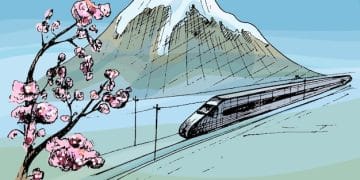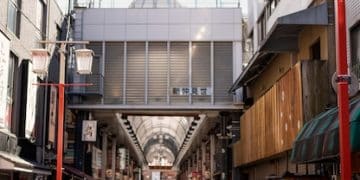Japan Public Transportation Etiquette: 2025 Guide for US Tourists
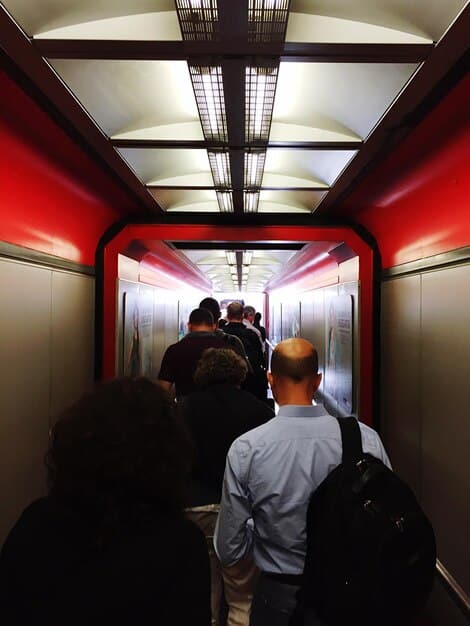
The Etiquette of Using Public Transportation in Japan: A 2025 Guide for US Tourists is important because it helps to promote harmony and avoid inadvertently causing offense, ensuring a smoother and more respectful travel experience for everyone involved.
Navigating Japan’s efficient and extensive public transportation system can be a breeze, but understanding the nuances of local customs is essential for a respectful and enjoyable experience. Our guide to
The Etiquette of Using Public Transportation in Japan: A 2025 Guide for US Tourists will prepare you for seamless travel.
Understanding Japanese Public Transportation Etiquette
Japanese public transportation is a marvel of efficiency and cleanliness. However, it also operates on a distinct set of cultural norms that might be unfamiliar to visitors from the United States. Learning these etiquette rules beforehand will greatly enhance your travel experience.
From boarding procedures to noise levels, respecting these customs shows consideration for fellow passengers and integrates you more seamlessly into Japanese society. This guide will walk you through the essential aspects to ensure a comfortable and respectful journey.
The Importance of Silence
One of the most noticeable aspects of Japanese public transportation is the quiet atmosphere. Loud conversations are generally frowned upon.
Mind Your Belongings
Be aware of how your bags and personal items affect those around you. Avoid blocking aisles or taking up extra seats.
- Keep conversations to a minimum and speak softly if necessary.
- Set your phone to silent mode and refrain from taking calls. Texting or using apps quietly is acceptable.
- Avoid playing music or videos without headphones.
By adhering to these practices, you contribute to the peaceful and harmonious environment valued on Japanese public transportation.
Understanding and following these basic rules is crucial for ensuring a smooth and culturally respectful travel experience on Japanese public transportation. By familiarizing yourself with these etiquette guidelines, you’ll be well-prepared to navigate the system with confidence and consideration.
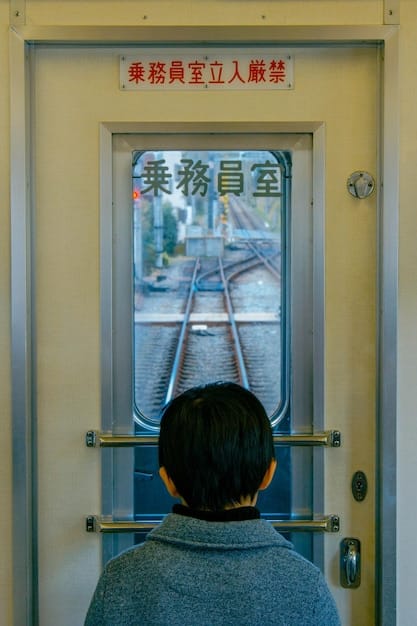
Boarding and Alighting: The Art of Queueing
Boarding and alighting from trains and buses in Japan is typically an orderly affair. Understanding the proper procedures can prevent confusion and demonstrate respect for local customs.
Queueing is a fundamental aspect of Japanese society, and this extends to public transportation. Knowing how and where to line up is crucial for a smooth boarding process.
Forming Lines
Look for designated queueing areas, which are often marked with lines or signage on the platform. Wait patiently and avoid cutting in line.
Letting Passengers Disembark First
Always allow passengers to exit the train or bus before attempting to board. This prevents congestion and ensures a smoother flow.
- Stand to the side of the door and allow exiting passengers to pass.
- Wait until the flow of passengers has subsided before stepping onto the vehicle.
- If there are no designated lines, form an orderly queue based on the order of arrival.
By following these simple guidelines, you contribute to the efficient and safe boarding process, making the experience more pleasant for everyone involved.
The smooth and efficient operation of Japanese public transportation relies heavily on the cooperation and consideration of its passengers. Understanding the proper boarding and alighting procedures is essential for a positive and respectful travel experience.
Mind the Gap: Safety and Awareness
Safety and awareness are paramount on Japanese public transportation. Paying attention to your surroundings and following safety guidelines ensures your well-being and that of others.
From navigating crowded platforms to being mindful of the train-platform gap, it’s essential to stay alert and take necessary precautions to avoid accidents.
Watching Your Step
Be mindful of the gap between the train or bus and the platform, especially when boarding and alighting. Watch your step to avoid tripping or falling.
Holding On
When standing, make sure to hold onto handrails or straps, especially during acceleration and deceleration. This helps prevent falls and injuries.
- Stay behind the yellow or white lines on the platform while waiting for the train.
- Avoid running on platforms or inside the vehicles.
- Be aware of emergency buttons and procedures in case of an accident or medical emergency.
By staying vigilant and adhering to these safety guidelines, you help create a secure environment for all passengers.
Prioritizing safety and awareness is crucial for a positive and secure travel experience while using Japanese public transportation. These simple precautions ensure your well-being.
Priority Seating: Understanding Needs
Priority seating, often designated with special markings, is reserved for passengers who require it most. Understanding who qualifies and how to offer your seat is a gesture of kindness.
These seats are specifically designated for elderly individuals, pregnant women, people with disabilities, and those with injuries. Recognizing the purpose of these seats demonstrates not only respect but also cultural sensitivity.
Identifying Priority Seats
Look for seats marked with special symbols or colors, usually indicating priority status. These are located near the entrances of trains and buses.
Offering Your Seat
If you are sitting in a priority seat and someone who needs it boards, offer your seat promptly. The gesture is often appreciated.
- Be observant of passengers who may need a priority seat, even if they don’t explicitly ask.
- If you are unsure whether someone needs a seat, it is always polite to offer.
- Avoid occupying priority seats unless you qualify or the vehicle is crowded.
Showing consideration for those who need it most fosters a sense of community, making the journey more comfortable for everyone.
Demonstrating a willingness to offer your seat reflects positively on you as a traveler, contributing to a more inclusive and compassionate environment on public transportation.
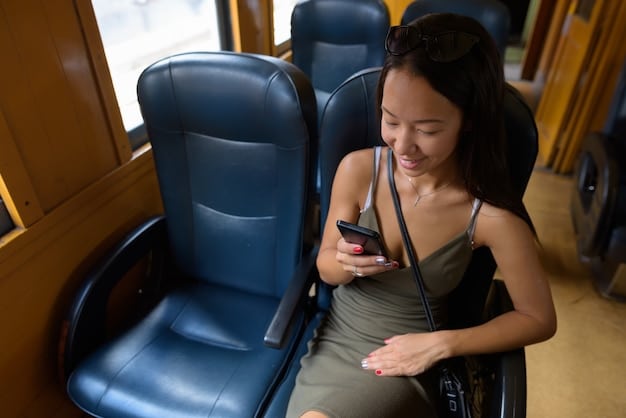
Eating and Drinking: Practicing Restraint
The rules regarding eating and drinking on public transportation in Japan are more nuanced. While not strictly prohibited, there are certain contexts where it’s considered acceptable or inappropriate.
Generally, eating and drinking are discouraged on local trains and buses, particularly during peak hours when vehicles are crowded. However, it is more acceptable on long-distance trains like the Shinkansen (bullet train).
When It’s Okay to Eat
On longer journeys, such as those on the Shinkansen, eating is typically acceptable. Many passengers even purchase bento boxes (lunch boxes) to enjoy during the ride.
When to Avoid Eating
Refrain from eating or drinking on crowded local trains and buses, especially during rush hour. The smell and potential for spills can be disruptive to other passengers.
- If you must eat or drink, do so discreetly and dispose of any trash properly.
- Avoid consuming messy or strongly scented foods that may bother other passengers.
- Be mindful of your surroundings and adjust your behavior accordingly.
By exercising moderation and consideration, you can navigate this aspect of Japanese etiquette with confidence.
Mindful eating and drinking habits enhance the overall travel experience, allowing you to indulge responsibly while minimizing any potential disturbance to your fellow travelers.
Luggage Handling: Considerate Space Management
Traveling with luggage on public transportation requires mindful space management. Consider how your belongings affect others and take precautions to minimize inconvenience.
Large suitcases and backpacks can take up valuable space and obstruct passageways, particularly during crowded times. Being considerate of others when managing your luggage is an important aspect of Japanese etiquette.
Using Luggage Racks
If available, utilize luggage racks or overhead compartments to store your bags. This keeps them out of the way and frees up space for other passengers.
Keeping Bags Close
In the absence of luggage racks, keep your bags close to you and avoid placing them on empty seats. Be mindful of how much space your belongings occupy.
- Avoid placing bags in the aisle where they can obstruct foot traffic.
- When standing, keep your backpack in front of you or at your feet to prevent bumping into other passengers.
- Be aware of the flow of people and adjust your luggage placement accordingly.
By practicing responsible luggage management, you demonstrate respect for the comfort and convenience of other passengers.
Thoughtful luggage handling is essential for a smooth and harmonious experience on Japanese public transportation. These considerations ensure everyone’s comfort.
| Key Point | Brief Description |
|---|---|
| 🤫 Silence is Golden | Keep conversations quiet and avoid loud noises. |
| 🧳 Manage Luggage | Use luggage racks and keep bags close to avoid blocking aisles. |
| ♿ Priority Seating | Offer seats to elderly, pregnant, or disabled passengers. |
| 📱 Phone Etiquette | Set phones to silent and avoid calls. Texting is usually acceptable. |
FAQ
▼
Generally, talking on the phone is discouraged in most areas of public transportation. It’s best to send a text, step outside, or use a messaging app instead.
▼
Eating is generally acceptable on long-distance trains like the Shinkansen, but it’s best to avoid eating on local lines, particularly during rush hours.
▼
If available, use the luggage racks or overhead compartments. If there are no compartments, keep your bags close to you and avoid placing them on empty seats.
▼
Priority seats are marked with special symbols or colors, usually indicating their reserved status for the elderly, pregnant women and disabled passengers.
▼
No, tipping is not expected and is often considered impolite in Japan. This applies to all types of service workers, including transit employees.
Conclusion
By familiarizing yourself with these etiquette guidelines, travelers can experience the unique efficiency and cultural harmony that characterizes Japanese public transportation. Adhering to these customs not only enhances your journey but also contributes to a smoother, more respectful environment for everyone involved.


